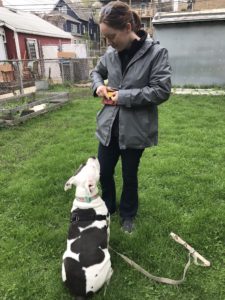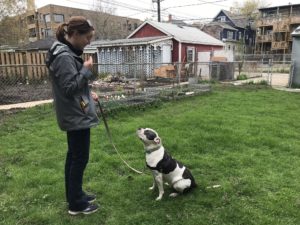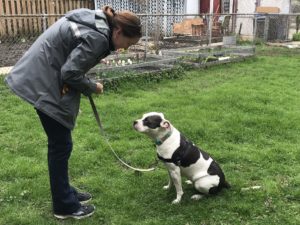May 3, 2019
 Congratulations! You have welcomed a new dog into your home. You have everything you need: a plush new dog bed, food and treats, an adorable collection of toys for your poochie to snuggle with, carry around, or potentially rip apart with glee.
Congratulations! You have welcomed a new dog into your home. You have everything you need: a plush new dog bed, food and treats, an adorable collection of toys for your poochie to snuggle with, carry around, or potentially rip apart with glee.
Now the trickier part…how do you teach your dog how to behave? To sit? Go to its crate? Not jump up when you come home from work? Training can seem like a daunting task, but it is an essential one. The training process is how we teach our dogs how to navigate our world, and can also provide an outlet through which to engage with our dog and help them channel their mental energy. It is a process that takes time and patience, just like when you’re teaching a person another language.
A good place to start is having an understanding of training methodology. While there is no “board standard” of dog training and different training professionals are likely to make a variety of recommendations based on their experience, the most popular philosophy is known as positive reinforcement training. This is the philosophy that Rover-Time keeps in mind when training their walkers or working with their clients. We also pride ourselves on working with trainers who follow it too. For learn more on what dog trainer Kiki Yablon says about positive reinforcement training, click here.
Awhile back, I heard Ken Ramirez speak on this topic. He helped define positive reinforcement training as: rewarding desired behaviors with various reinforcers (the most common and effective are treats). Positive reinforcement training does NOT use positive or negative punishment for undesired behaviors. What’s the difference?
- Positive Punishment (hitting the dog, for example) — adds something to a situation to punish a dog
- Negative Punishment (taking away the dog’s access to food, water, etc.)– removing something to punish a dog.
Instead, positive reinforcement training encourages redirecting a dog to the desired behavior and not using any type of punishment against the dog. So what do you use to reinforce a behavior?
- Primary reinforcer — is an effective reward because it satisfies a basic need (i.e., treats, food)
- Secondary reinforcer — Something that acquires value through association with a primary reinforcer.
 When you begin working with your dog, most trainers would recommend starting with treats to keep things simple. As continue training together, adding a secondary reinforcer can be a fun new element to your routine. Examples of secondary reinforcers includes things like a toys, play time, clapping, or a specific touch as a reward for the desired behavior you’re seeking more of.
When you begin working with your dog, most trainers would recommend starting with treats to keep things simple. As continue training together, adding a secondary reinforcer can be a fun new element to your routine. Examples of secondary reinforcers includes things like a toys, play time, clapping, or a specific touch as a reward for the desired behavior you’re seeking more of.
Now that you know all these vocab words, how do you apply all these cool new things to real life? Training a dog to perform a certain task can be broken down into an easy series of steps:
- Giving a command — give a dog a cue word and/or gesture to perform a behavior
- “Marking” a command — this means putting a mark on the moment the dog has performed the behavior. This can be a word you elect to say or a noise you make (using a “clicker” is common for this part of the process).
- Rewarding a command — giving a dog their reward that reinforces their behavior.
The key to making a good connection between a behavior you want to be repeated is proper use of timing. Dogs’ brains work very differently from ours and live VERY in the moment. It’s very important that you “mark” a command and reward it quickly after. You have about 1.5 seconds to make sure your dog is connecting the treat to the action it just performed.
Now you’re thinking ok Katie, how does this end up looking? How much time does it take? Will I have the patience to do all this? Well, it will depend on what you want to teach your pup and what your dog is like. Each dog is as unique as a star in the sky and needs different things. Breaking down training sessions to short sessions can help you ensure that you’ll have fun and can take a step at a time with your pup.
What I can do is leave you with a short video that demonstrates everything I’ve just mentioned. You can watch this trainer teach this sweet poochie pie named Spike how to sit.
Are you feeling energized and ready to learn more!? Here’s some more fun articles from our trainer friend, Kiki Yablon:
Seven Things To Teach Your New Puppy
How To Reduce Your Dog’s Barking at the Door
Have fun teaching your fluffy fur-child the ways of the world! I believe in you!

Katie Sullivan is a Team Manager at Rover-Time and has been with the company since 2015. She lives in Ravenswood with her two roommates and a pittie named Gretchen. A Michigan transplant, she has been in Chicago for 5 years and is so happy to be here. She enjoys being involved in occasional theatrical productions and drinking oaky chardonnays.

Recent Comments